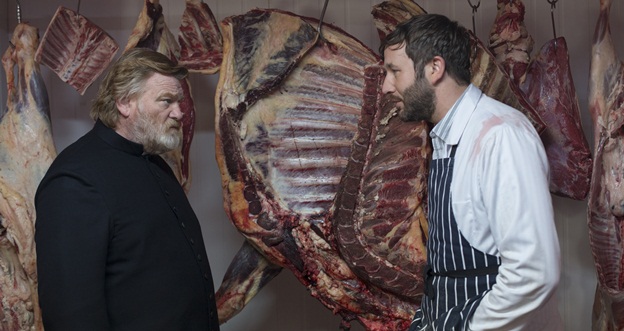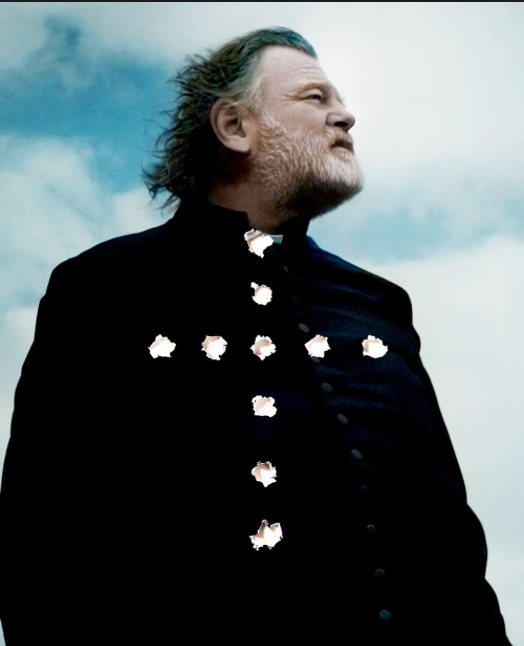 Calvary begins with a close-up of a priest in a confession booth. “I was seven years old when I first tasted semen,” an off-screen voice announces. “Certainly a startling opening line,” the priest (Brendan Gleeson), who is known as Father James, responds. We could say the same of this film, which boldly lays out its agenda – witness its name, after all – not to convert us so much as to incite us to ponder our own agendas instead.
Calvary begins with a close-up of a priest in a confession booth. “I was seven years old when I first tasted semen,” an off-screen voice announces. “Certainly a startling opening line,” the priest (Brendan Gleeson), who is known as Father James, responds. We could say the same of this film, which boldly lays out its agenda – witness its name, after all – not to convert us so much as to incite us to ponder our own agendas instead.
The unnamed voice goes on to say that, in a week, he will kill Father James because he is not a malfeasant like the priest who sexually abused him for years: The death of a “good priest” will make a statement. Cards thus on the table, James is left to sort out his affairs as well as the identity of his would-be killer. Consider this as a pre-crime procedural, then (the press notes describe it as a “who’s-gunna-do-it”)–one that is so formally constructed that we may surrender to James’ soul-searching in both senses of that term.
If all this sounds awfully literary – a sort of Swedish mystery set afire with ancient Irish angst – that’s not a coincidence. At a recent Q&A at The Museum of the Moving Image, writer/director John Michael McDonagh described himself as a “failed novelist.” But while many films of such portent might benefit from being a book instead, Calvary is ideal in its current medium. Its claustrophobic interiors, contrasted with the surf and sky of the Irish sea town where it is set, wordlessly remind us of the harsh beauty and isolation that is the human condition. And that world beyond words, the one that exists beneath the nattering of daily life, better evokes the divine experience, which is precisely what this film invites us to ponder during its 100 minutes.
Though Father James may be a “good priest,” he’s got very few genuine fans. He is, after all, a representative of an institution that many feel has outlasted its utility, not to mention overstayed its welcome, and as he visits village denizens – a chief inspector and his rent boy who speaks in 1940s American gangster “dese” and “dose”; a butcher (Chris O’Dowd in his native accent for once) who’s grateful his wife cheats on him so he can spend more time at the pub; a coke-snorting doctor (Aidan Gillen) who considers himself “ten percent humanism, ninety percent gallows humor”; a fading American writer (M. Emmet Walsh); an alcoholic, arrogant tycoon (Dylan Moran) – it becomes clear that any of these broken men could be his potential assassin. Still, James is looking to connect them to their best selves rather than force them into the shape the Church might expect. Despite the old-fashioned robes he insists on wearing (more Jesus references!), this is a modern priest in unhappily modern times – times when it’s not clear whether spiritual values of compassion and integrity can outlive the religious framework in which they’ve been traditionally taught.
 A longtime collaborator with the Brothers McDonagh (he previously starred in Martin McDonagh’s In Bruges as well as John Michael’s The Guard), Gleeson has said he was so deeply involved in this project early on that he influenced the writing of the script, particularly of his character. This may be unusual in the development of a film yet it’s not surprising here: It’s hard to imagine anyone but Gleeson as Father James. He summons a jarring combination of old-soul compassion and dry, almost withering wit that is more commonly found in life than on celluloid. Especially when we learn that Father James was married (his wife died before this film begins) and has a suicidal adult daughter Fiona (played with deft melancholy by Kelly Reilly), we recognize him as a man who struggles with his own demons, which include not only alcoholism but impatience and judgmentalism. James is a good man not because acceptance and forgiveness are his inherent traits but, rather, because they are his goals.
A longtime collaborator with the Brothers McDonagh (he previously starred in Martin McDonagh’s In Bruges as well as John Michael’s The Guard), Gleeson has said he was so deeply involved in this project early on that he influenced the writing of the script, particularly of his character. This may be unusual in the development of a film yet it’s not surprising here: It’s hard to imagine anyone but Gleeson as Father James. He summons a jarring combination of old-soul compassion and dry, almost withering wit that is more commonly found in life than on celluloid. Especially when we learn that Father James was married (his wife died before this film begins) and has a suicidal adult daughter Fiona (played with deft melancholy by Kelly Reilly), we recognize him as a man who struggles with his own demons, which include not only alcoholism but impatience and judgmentalism. James is a good man not because acceptance and forgiveness are his inherent traits but, rather, because they are his goals.
The many colors of the priest’s personality are reflected in the complex, shifting tone of the overall film. McDonagh has said he doesn’t like the concept of “tone,” and I think he means he doesn’t like getting hemmed into one prevailing mood. Certainly this movie is so tragic and comic – the language is so sharp, the placement so austere, the emotions so high-pitched – that it’s less literary than operatic. Even the visual palette veers dramatically between the purified grays and whites of this ocean-side terrain and the ecstatic hues – royal reds and Mother Mary blues – that we associate with the Church and a sunny day.
What’s most operatic about this film, though, is its big-ticket interrogation: It’s about what drives people to terrible acts and despair. It’s about the difficulty of maintaining faith in a difficult world. It’s about what “faith” is in the first place. And it’s about the struggles of the Church to remain relevant – even tolerable – in a country and in a world beset by economic and social injustice, especially as it’s lost so much credibility in the shadow of many instances of sexual abuse.
And this brings us back to the machinery that drives this plot forward. There’s an ambivalence to James’ search, as if he is marching toward his death and self-destruction even as he takes halfhearted steps to prevent it. We get the sense this is because he’s no longer sure of the relevance of his work. Certainly he’s not sure whether he accepts the institution of the Church so much as the values it’s supposed to represent.
That ambivalence is mirrored in everyone’s response to Fiona’s bandaged wrists. The priest’s first, typically dry comment to her – “classic mistake!” (she cut them horizontally rather than vertically) – is echoed by others as the story progresses. But James’s deep sorrow and rage about his daughter’s attempt to take her own life eventually emerges. What we don’t see is him climbing on a high horse though suicide is considered a mortal sin by his own church. (“We should focus more on virtues and less on sins,” he says.) Really, James is dancing between his role as a father – by dying, he will be abandoning his already-bereft daughter – and his role as a Father–that is, as a stand-in for a church drowning in its bad blood. But just how far will he take this Jesus metaphor?
Like all worthy art about divinity – and it’s an unhappy irony that the more that we need such art, the less it is made – this film never tells us what to think so much as it suggests what we should be thinking about. Despite an emphatic conclusion, “Calvary” poses more questions than it answers, and this is to its credit.
A version of this review originally appeared in Word and Film.
